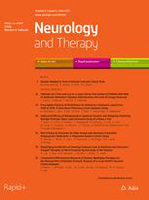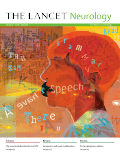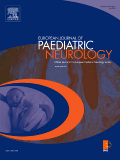
Neurology and Therapy
Scope & Guideline
Transforming Patient Outcomes with Cutting-Edge Neurological Research
Introduction
Aims and Scopes
- Neurological Disorders and Treatments:
The journal focuses on a wide range of neurological conditions including Alzheimer's disease, multiple sclerosis, Parkinson's disease, epilepsy, and migraine, with a commitment to exploring both pharmacological and non-pharmacological treatments. - Patient-Centric Research:
A significant emphasis is placed on understanding patient experiences, treatment preferences, and quality of life. Research often incorporates qualitative methods to gauge patient perspectives on their conditions and treatments. - Innovative Therapeutic Approaches:
The journal highlights advancements in treatment modalities, including novel drug therapies, biologics, and emerging technologies such as deep brain stimulation and virtual reality interventions. - Real-World Evidence and Clinical Practice:
Research published often includes real-world studies and meta-analyses that assess the effectiveness and safety of treatments in diverse patient populations, thereby bridging the gap between clinical trials and everyday clinical practice. - Biomarkers and Diagnostic Tools:
The journal explores the development and application of biomarkers and diagnostic methods that aid in the early detection and management of neurological disorders, enhancing personalized treatment strategies.
Trending and Emerging
- Real-World Evidence and Patient Outcomes:
There is a growing trend towards studies that utilize real-world data to assess the effectiveness and safety of treatments, emphasizing the importance of patient outcomes and experiences in clinical decision-making. - Telehealth and Digital Therapeutics:
The rise of telehealth and digital therapeutic interventions has become a focal point, particularly in the context of the COVID-19 pandemic, as researchers explore their efficacy in managing neurological conditions. - Personalized Medicine and Biomarkers:
Research focusing on personalized medicine, particularly the use of biomarkers to tailor treatments to individual patient profiles, is increasingly prominent, reflecting advancements in genetic and molecular research. - Multimodal Approaches to Treatment:
An emerging trend is the exploration of multimodal treatment strategies that combine pharmacological, behavioral, and rehabilitation therapies, aiming for a more holistic approach to patient care. - Neuroinflammation and Neurodegeneration Research:
There is a notable increase in studies investigating the role of neuroinflammation in various neurological disorders, as researchers seek to uncover new therapeutic targets and mechanisms.
Declining or Waning
- Traditional Pharmacotherapy for Chronic Conditions:
There is a noticeable reduction in studies focusing solely on traditional pharmacological approaches to chronic neurological conditions, as the field increasingly embraces combination therapies and integrative treatment models. - Basic Science Research:
Research articles centered on basic science or purely mechanistic studies are becoming less frequent, possibly due to a shift in focus towards clinical applications and real-world effectiveness. - Longitudinal Studies:
The prevalence of longitudinal studies examining the long-term outcomes of treatments appears to be decreasing, potentially replaced by more immediate efficacy studies or innovative trial designs. - Conventional Rehabilitation Approaches:
There is a decline in publications focused on conventional rehabilitation methods, as newer technologies and therapeutic approaches (like virtual reality) gain traction in the field. - Epidemiological Studies of Rare Neurological Disorders:
Research on rare neurological disorders has seen a decrease, possibly due to the challenges in recruiting large cohorts and the increasing focus on more prevalent conditions or conditions with broader impact.
Similar Journals

LANCET NEUROLOGY
Innovative Discoveries for Tomorrow's NeurologistsThe Lancet Neurology is a premier academic journal published by Elsevier Science Inc, specializing in the field of neurology. With a robust impact factor that signifies its authoritative presence, it consistently ranks in the Q1 category for clinical neurology according to the 2023 standards, positioning itself as the leading journal in its domain, ranking #1 out of 400 in Scopus' neurology rankings and placing in the 99th percentile. Since its establishment in 2002, it has provided a vital platform for disseminating innovative research and clinical advances related to neurological disorders. The journal’s precise focus includes cutting-edge studies on neurodegenerative diseases, stroke, epilepsy, and neuroimaging, which are essential for advancing clinical practice and improving patient outcomes. While it does not offer open access, readers can find high-impact research published monthly, making it indispensable for practitioners, researchers, and students eager to stay at the forefront of neurological science.

Clinical Parkinsonism & Related Disorders
Exploring the complexities of neurological disorders.Clinical Parkinsonism & Related Disorders is a prominent open-access journal published by Elsevier, focused on advancing the understanding and treatment of Parkinson's disease and related neurological conditions. Since its inception in 2019, this journal has aimed to provide a platform for high-quality research, review articles, and clinical studies dedicated to elucidating the complexities of Parkinsonism and its comorbidities. With an E-ISSN of 2590-1125, it has swiftly established its role in the field of clinical neurology, currently ranked in the Q3 quartile for clinical neurology and Q4 for cellular and molecular neuroscience. While its Scopus rankings reflect a competitive landscape, occupying the 241st position in clinical neurology and the 83rd in neuroscience, the journal remains committed to fostering scholarly dialogue and supporting innovative research. Researchers, clinicians, and students will find valuable insights within its pages, contributing to ongoing discourse and the pursuit of effective therapeutic strategies. Access to all articles has been made available since 2019, emphasizing the journal's mission to disseminate knowledge widely and enhance accessibility in the scientific community.

CURRENT OPINION IN NEUROLOGY
Connecting Knowledge and Practice in Neurology.CURRENT OPINION IN NEUROLOGY is a premier academic journal dedicated to providing insightful overviews and critical analyses across all areas of neurology and clinical neurology. Published by Lippincott Williams & Wilkins, this esteemed journal boasts an impressive impact factor, highlighting its influence and relevance in the field—positioning it in the Q1 category for both neurology and clinical neurology as of 2023. With its comprehensive coverage, the journal serves as a vital resource for researchers, healthcare professionals, and students aiming to stay abreast of the latest developments, trends, and breakthroughs in neurological science and practice. Though not open access, articles are available via institutional subscriptions or individual purchase, ensuring that vital research remains accessible to a wide audience. Covering research from its inception in 1993 to ongoing studies in 2024, CURRENT OPINION IN NEUROLOGY stands out as an essential platform for disseminating knowledge and fostering dialogue within the dynamic and evolving landscape of neurology.

PARKINSONISM & RELATED DISORDERS
Connecting research with real-world impact.PARKINSONISM & RELATED DISORDERS, published by Elsevier Science Ltd, is a prominent peer-reviewed journal dedicated to advancing the understanding of Parkinson's disease and related neurodegenerative disorders. With an impact factor placing it in the Q2 category across multiple fields including Geriatrics and Gerontology and Neurology for 2023, this journal serves as a crucial platform for researchers, healthcare professionals, and students alike. Covering an array of topics from clinical trials to innovative therapeutic strategies, it aims to disseminate valuable insights that can improve patient care and outcomes. While it remains a subscription-based journal, its relevance is underscored by its consistent rankings in Scopus, where it ranks 105th in Clinical Neurology and 35th in Geriatrics and Gerontology. Authored by top scholars in the field, PARKINSONISM & RELATED DISORDERS continues to contribute significantly to the body of knowledge surrounding these debilitating conditions, facilitating the exchange of cutting-edge research and fostering collaboration within the scientific community.

FORTSCHRITTE DER NEUROLOGIE PSYCHIATRIE
Bridging the Gap Between Neurology and PsychiatryFORTSCHRITTE DER NEUROLOGIE PSYCHIATRIE is a pivotal journal in the fields of neurology, psychiatry, and related medical disciplines, published by GEORG THIEME VERLAG KG in Germany. With a history dating back to 1955, this journal has evolved to address the dynamic nature of neurological and psychiatric research, offering valuable insights and advancements in the field. Despite holding a Q4 category status in various medical domains according to the 2023 quartiles, the journal continues to foster academic discussion and engagement among researchers and clinicians alike. It serves as a vital platform for disseminating knowledge through original research articles, reviews, and clinical studies, making it an essential resource for professionals and students aiming to stay abreast of the latest developments in mental health and neurological science. Although the journal currently does not offer open access options, its contribution to the academic community is significant, helping to illuminate the intricate relationships between neurological disorders and psychiatric conditions.

Multiple Sclerosis International
Fostering collaboration, driving innovation in neurological science.Multiple Sclerosis International is a leading open-access journal dedicated to advancing the scientific understanding of multiple sclerosis (MS) and related neurological disorders. Published by HINDAWI LTD since 2010, this journal serves as a vital resource for researchers, clinicians, and students alike, providing a platform for high-quality peer-reviewed articles that cover a diverse range of topics, including epidemiology, treatment strategies, and the latest advancements in MS research. With its commitment to open access, Multiple Sclerosis International ensures that critical findings are readily available to the global community, fostering collaborative efforts to improve patient outcomes and advance therapeutic approaches. The journal not only enhances scholarly discourse in the field but also significantly impacts clinical practices by presenting cutting-edge research and insights.

Annals of Indian Academy of Neurology
Empowering Minds, Transforming NeurologyAnnals of Indian Academy of Neurology is a premier open access journal dedicated to advancing the field of Neurology, serving as a vital resource for researchers, healthcare professionals, and students since its inception in 2006. Published by the esteemed Wolters Kluwer Medknow Publications, this journal has established itself within the academic community, boasting a Q3 quartile ranking in clinical neurology according to the 2023 category quartiles and a Scopus rank placing it in the 35th percentile among 400 comparable journals. With a focus on clinical advancements and research innovations in neurology, the journal aims to disseminate high-quality and impactful studies that address the complex challenges faced in the neurological landscape, particularly within the Indian context. The open access model ensures that the latest research is readily accessible to a global audience, thereby promoting collaboration and knowledge sharing within the neurosciences.

Expert Review of Neurotherapeutics
Exploring New Horizons in NeurotherapyExpert Review of Neurotherapeutics is an esteemed journal published by Taylor & Francis Ltd, focusing on the rapidly evolving field of neurotherapeutics. With an ISSN of 1473-7175 and an E-ISSN of 1744-8360, this publication aims to bridge the gap between clinical and preclinical research, providing a platform for innovative therapeutic strategies in neurology and neuroscience. The journal boasts impressive impact factor rankings, categorized as Q2 in both clinical neurology and miscellaneous neuroscience, and Q1 in medical pharmacology for 2023. Its reputable placement in Scopus rankings, including Rank #82/400 in clinical neurology, underscores its significance within the medical research community. Spanning from 2001 to 2024, the journal publishes critical reviews and original research articles aimed at enhancing understanding and treatment in neurological disorders. Although it currently does not offer open access, articles published in the journal are crucial for researchers, healthcare professionals, and students seeking to stay at the forefront of advancements in neurotherapeutics. With its strong emphasis on rigorous peer-reviewed content, Expert Review of Neurotherapeutics continues to be a vital resource for those dedicated to improving patient outcomes in the realm of neurology.

EUROPEAN JOURNAL OF PAEDIATRIC NEUROLOGY
Transforming clinical practice with cutting-edge findings.European Journal of Paediatric Neurology, published by Elsevier Science Ltd, is a premier academic journal dedicated to advancing the field of paediatric neurology. With its ISSN 1090-3798 and E-ISSN 1532-2130, this journal serves as a vital resource for researchers, clinicians, and students alike, focusing on the latest findings and innovative treatments in paediatric neurological disorders. The journal has established itself as a leading publication in its field, achieving a Q1 classification in Pediatrics, Perinatology and Child Health, and holding a reputable Q2 status in Clinical Neurology as of 2023. Positioned within the top 88th percentile in Pediatrics and the 76th percentile in Clinical Neurology according to Scopus ranks, it publishes rigorous peer-reviewed articles that contribute significantly to clinical practice and research. Although not open access, the journal provides vital insights into the complexities of neurological conditions affecting the pediatric population, making it an essential tool for scholars and professionals striving to improve child health outcomes. With a publication trajectory spanning from 1997 to 2024, it continues to be at the forefront of paediatric neurological research, inspiring innovation and collaboration in the scientific community.

Aktualnosci Neurologiczne
Your Gateway to Cutting-Edge Neurological InsightsAktualnosci Neurologiczne is a renowned open-access journal dedicated to the field of neurology, published by Medical Communications. As a crucial platform for the dissemination of neurological research, it has been operational since 2005, fostering an inclusive environment for scientific discourse and innovation. With an ISSN of 1641-9227, the journal aims to bridge the gap between clinical practice and research, offering a diverse range of articles that cover the latest developments in neurological science. Although its coverage in Scopus was discontinued after 2017, the journal continues to maintain a robust archive of scholarly articles that contribute to understanding neurological disorders. Researchers, healthcare professionals, and students interested in the latest trends and studies in neurology will find Aktualnosci Neurologiczne an invaluable resource, providing insights that drive advancements in the field. The journal operates from its address in Warsaw, Poland, and invites contributions from the global research community to enrich its content and impact.